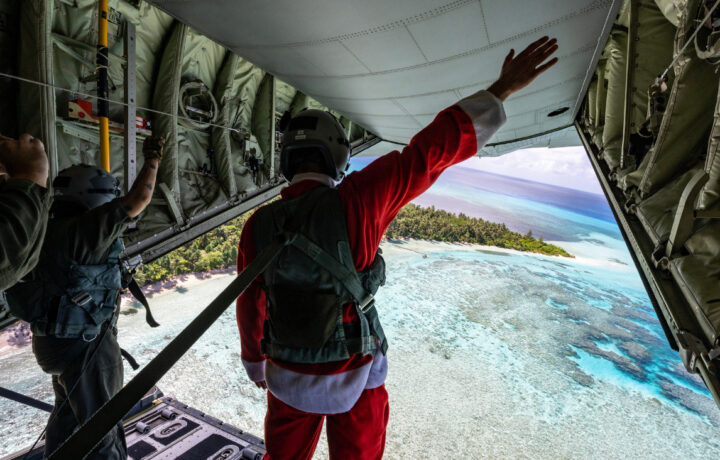While it is Santa Claus who delivers toys to good boys and girls around the world on Christmas Eve, and is even tracked by NORAD each year, the United States Air Force also does its part to provide goods to islanders throughout Micronesia as part of what is now the Pentagon’s longest-running humanitarian airlift operation.
The tradition began during the Christmas season in 1952 when a B-29 Superfortress aircrew saw islanders waving at them from the island of Kapingamarangi, 3,500 miles southwest of Hawaii. In the spirit of Christmas, the aircrew gathered some items they had on the plane, attached the bundle of supplies to a parachute, and dropped it to islanders below, giving the operation its name.
At the time, the island had no electricity or running water and was periodically hit by typhoons.
While certainly meant to be good deeds, the first Christmas Drops that followed weren’t exactly a success. Some containers fell into the water, while others weren’t discovered for months, but the Air Force honed it skills and the program has continued to grow over the past seven decades.
Today, airdrop operations include more than 50 islands throughout the Pacific.
Conducted From Guam Not the North Pole
While Santa’s base of operation remains in the North Pole, Andersen Air Force Base (AFB), Guam, has been the “base camp” to airlift donated goods to the islanders throughout Micronesia.
Operation Christmas Drop is a PACAF event that includes a partnership between the 374th Airlift Wing, Yokota Air Base, Japan; the 36th Wing, Andersen Air Force Base, Guam; 734th Air Mobility Squadron, Andersen AFB of the 515th Air Mobility Operations Wing, Joint Base Pearl Harbor-Hickam, Hawaii; the University of Guam; and the ‘Operation Christmas Drop’ private organization which leads the fundraising and donations for the operation.
C-130J Super Hercules crews airdrop food, supplies, educational materials, and toys to islanders throughout the Federated States of Micronesia, and the Republic of Palau. These islands are some of the most remote locations on the globe spanning a distance nearly as broad as the continental U.S. Though Santa can travel around the globe, the PACAF has proven also to be up to the challenge of reaching the far-flung islands.
Still Fairly Low Tech
Operation Christmas Drop relies on C-130J Super Hercules transport aircraft rather than a reindeer-powered sleigh, but the airlift operation remains rather low-tech, as aircrews are linked to the village via ham radio as they fly overhead and drop supplies.
PACAF has noted that the event provides readiness training to participating aircrew, allowing them to gain experience in conducting airdrops while providing critical supplies to 56 Micronesian islands impacting about 20,000 people; and that “ultimately it’s a profound win for everyone involved.”
The Low Cost Low Altitude (LCLA) airdrop has also been described as an incredibly cost-efficient and easy to apply across the global airlift community, as it can utilize readily available resources and repurposed personnel parachutes to build supply pallets at a fraction of the cost of other airdrop bundles. In addition, the pallets are dropped at low altitudes to improve drop accuracy.
An International Effort
Just as Santa Claus doesn’t need a passport as he travels the world, Operation Christmas Drop has increasingly become an international effort.
In 2015, the Japan Air Self-Defense Force (JASDF) and the Royal Australian Air Force (RAAF) participated in the operation along with the U.S. Air Force. Japan and Australia each provided one C-130 Hercules to join the three C-130s provided by the United States. The Philippine Air Force joined in 2017, and this year the Royal Canadian Air Force took part.
During the global pandemic in 2020, the U.S. Air Force also took extra precautions to prevent the spread of Covid-19 from deliveries.
Better Than an Army of Elves
Santa has nothing on PACAF’s ability to get the job done. Months leading up the drop dates volunteers create donation drop-off boxes and raise money from local businesses and citizens.
Then, a week before the drop, volunteer Airmen, Soldiers, Sailors, Marines, civilians, contractors and families assist in picking up and sorting the donations. After the goods are sorted, riggers from Yokota and Andersen volunteers build dozens of boxes to hold the materials, most containing school supplies, clothing, rice, fishing equipment and of course no shortage of toys.




